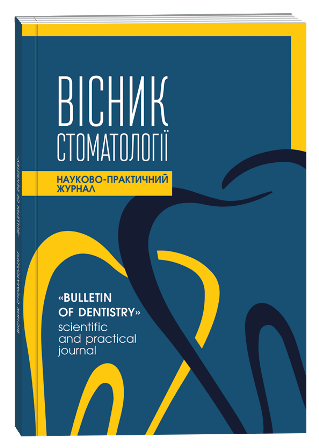ASSESSMENT OF DENTAL HARD TISSUE AFTER PEROXIDE WHITENING
DOI:
https://doi.org/10.35220/2078-8916-2024-51-1.13Keywords:
teeth whitening, enamel resistance, oral fluid, dental hard tissue condition.Abstract
The aim of the present study was to assess the condition of hard tooth tissues after their whitening. Research materials and methods. The study agreed to take part 44 people aged 19 to 27 years ‒ 37 women and 7 men who, when surveyed, confirmed that they had previously performed teeth whitening. Tooth whitening was performed using peroxides. The following tasks were set: 1. To determine the prevalence of dental hyperesthesia that developed after chemical whitening in individuals who underwent whitening in the range of 6-7 months ago. 2. Study the mineralizing potential of oral fluid and the degree of development of dental demineralization. results. The first stage of research concerned the assessment of the dental status of patients before teeth whitening. Analysis of the results indicated a high prevalence of hard tissue damage in the examined patients, of which 91% were of carious origin and 18.2 % were of non-carious origin. And this was a risk for the deterioration of the situation regarding the increase in the permeability of enamel, and, as a result, the development of hypersensitivity of teeth after their whitening. Enamel resistance results were consistent with moderate acid resistance When assessing the mineralizing potential of oral fluid by type of salivary crystallization, it was found that the smallest number of people (21 %) had the most favorable type 1.And type 3, the most unfavorable, in which there is a complete absence of crystals in the field of view, was detected in most patients. After assessing the dental status of patients, studies were conducted that examined the effect of tooth whitening on their condition in the subsequent period. To assess the condition of enamel in persons with dental hyperesthesia, special clinical tests were used, namely a resistance test, and the mineralizing potential of oral fluid was also determined.With the help of the latter, it is possible to indirectly assess whether the oral fluid contains enough basic minerals to carry out the mineralization and remineralization process. The results of the evaluation of enamel resistance showed that the average indicator corresponded to moderate acid resistance of enamel. Moreover, most of all there were people with high and moderate resistance (14 people); low and very low resistance was detected in 10 people. This indicated that, although studies were not conducted immediately after bleaching, enamel resistance was reduced.
References
Мороз К.А. Карієс і некаріозні ураження твердих тканин зубів. Вінниця: Нова Книга, 2012. 240 с.
Mounika A., Mandava J., Roopesh B., Karri G. Clinical evaluation of color change and tooth sensitivity with in-office and home bleaching treatments. Indian J. Dent. Res. 2018. № 29. 423–427 doi: 10.4103/ ijdr.IJDR_688_16.
Терешина Т. П. Зубачик О.В. Соціологічні аспекти проблеми гіперестезії зубів. Вісник проблем біології і медицини. 2014. Т. 2(114). № 4. С. 337–340.
Addy М. Dentin hypersensitivity: new prospects for the old problem. International Dental Journal. 2014. Vol.52. № 5. P. 367-375. ttps://doi.org/10.1002/ j.1875-595X.2002.tb00936.x
Іваницький І. О. Гіперчутливість зубів. Сучасні погляди на етіологію, патогенез та лікування. Актуальні проблеми сучасної медицини. 2007. Т. 7. Вип. 4 (20). С. 339–345. http://repository. pdmu.edu.ua/handle/123456789/6569
Білоклицька Г.Ф., Копчак О.В. Структурна характеристика твердих тканин зубів при гіперестезії дентину, що виникла на фоні захворювань пародонта. Український медичний часопис. 2004. № 6. С. 67-72.
Заболотна І.І., Богданова Т.Л. Аналіз показників гіперестезії дентину у молодих людей і їх зв`язок із цервікальною патологією зубів. Вісник стоматології. 2022. № 4 (121). C. 26-31 https://doi.org/10.35220/2078- 8916-2022-46-4.5
Barros Oliveira Antonia Patricia, Pompeu Danielle da Silva, Takeuchi Elma Vieira, Alencar Cristiane de Melo, Alves Eliane Bemerguy, Silva Cecy Martins. Effect of 1.5 % potassium oxalate on sensitivity control, color change, and quality of life after at-home tooth whitening: A randomized, placebo-controlled clinical trial. PLoS One. 2022. № 17(11). Р. e0277346. doi: 10.1371/journal. pone.0277346 9. Edson de Sousa Barros Júnior, Mara Eliane Soares Ribeiro, Rafael Rodrigues Lima, Mário Honorato da Silva e Souza Júnior, Sandro Cordeiro Loretto. Excessive Dental Bleaching with 22% Carbamide Peroxide Combined with Erosive and Abrasive Challenges: New Insights into the Morphology and Surface Properties of Enamel. Materials (Basel). 2022. № 15(21). Р. 7496. doi: 10.3390/ ma15217496 10. Демидова П.І., Рябоконь Є.М. сучасні погляди на етіологію, патогенез та лікування гіперестезії зубів. експериментальна та клінічна стоматологія. 2018. № 4 (05). С. 3-7.
Yu Jian, Bian Haolin, Zhao Yaning Guo Jingme, Yao Chenmin et al. Epigallocatechin-3-gallate/mineralization precursors co-delivery hollow mesoporous nanosystem for synergistic manipulation of dentin exposure. Bioact Mater. 2023. № 23. Р. 394–408. doi: 10.1016/j. bioactmat.2022.11.018.









